Briefly: In our opinion, full (150% of the regular full position) speculative short positions in gold, silver and mining stocks are justified from the risk/reward perspective at the moment of publishing this alert.
Gold, silver and mining stocks moved higher yesterday while the USD Index declined. In fact, it was the biggest daily decline in the latter in almost 3 weeks and it took place right after the RSI based on the USD Index touched the 70 level. Have we just seen a reversal in currencies and precious metals?
In short, we have likely not seen a reversal, just a pause. We already commented on the RSI for the USD Index as something that doesn’t concern us. In yesterday’s alert, we wrote the following (chart courtesy of http://stockcharts.com).
What about the USD Index? Surely it’s reversal had some bearish implications which should be bullish for the precious metals sector?
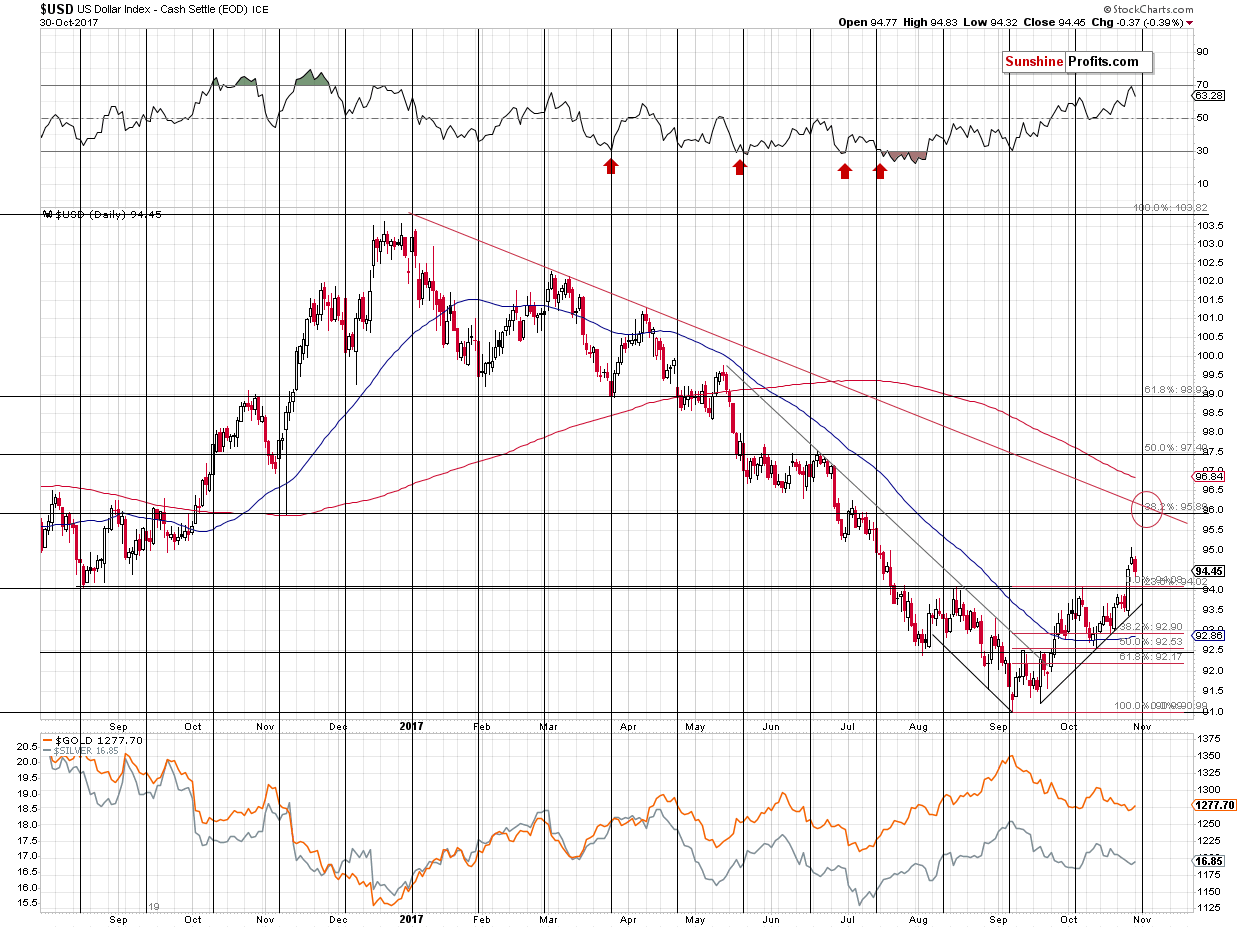
Not necessarily. Well, to be honest, a daily reversal IS a bearish sign when it’s seen after a rally, but in light of the breakout above the neck level of the reverse head-and-shoulders formation and a weekly close above it, it seems that Friday’s session can be viewed as bullish precisely because it ended without invalidating the mentioned breakout.
In light of the latter, even if the USD is to reverse here, it’s likely to move lower only to the previously broken neck level (94). Consequently, the downside is very limited and such a small downswing could simply be a verification of the breakout. So, are the implications really bearish for the USD? In our view, not really.
Even though the USD Index could move a bit lower in the short run, our previous comments remain up-to-date:
Moving on to the star of yesterday’s session, we see that the reverse head and shoulders formation was clearly completed and the implications are very bullish. Still, let’s keep in mind that the formation could still become invalidated and if that happens, the USD would be likely to move to 92.5 or lower – maybe even to the 91 bottom. This is not likely, but we want to prepare you for this possibility. At the moment of writing these words, the USD Index is trading at 94.86, so it has a long way down to invalidate the breakout above 94 and – again – the invalidation of the breakout doesn’t appear likely, but it should be kept in mind nonetheless.
What is likely is the scenario that we had outlined previously – a quick run to the 95.5 – 96.5 area (96 being the most likely target) followed by a local (not the final one) top in early November.
The RSI indicator is moving close to the 70 level, but that doesn’t concern us as in the recent past there were only 2 similar cases - about a year ago. In both of them, the USD Index continued to rally to much higher levels before the top was in (PMs continued to decline).
The USD Index moved lower, but didn’t invalidate the breakout above the neck level of the head-and-shoulders formation so the implications remain clearly bullish, especially that it was the third consecutive day above the neck level. The breakout is now verified by practically all signals (3 consecutive closes, a weekly close and the size of the move after the breakout).
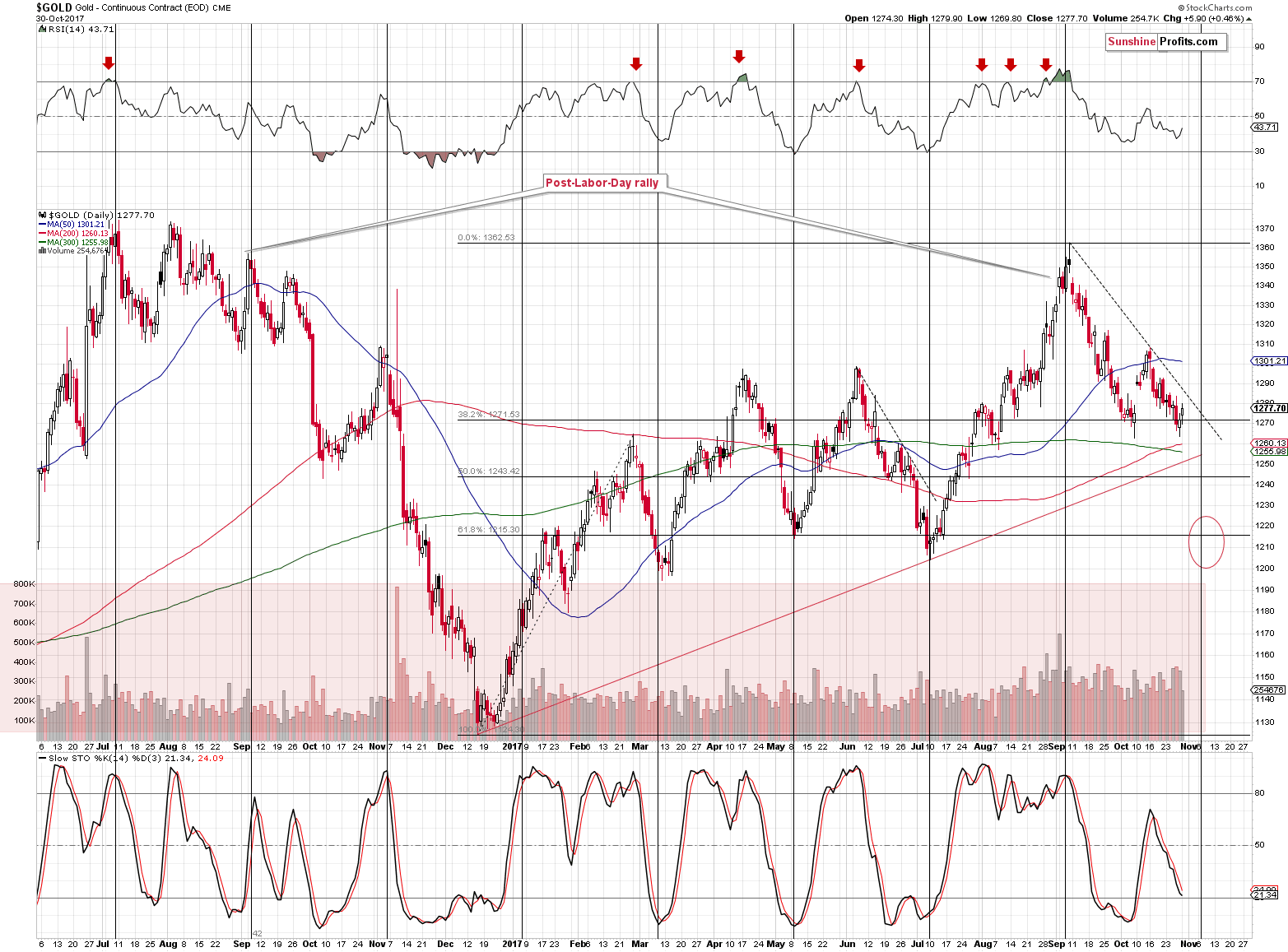
Gold moved higher on relatively low volume, which is a classic indication that what we’re seeing is a pause. If gold is not done correcting, it seems that it will not move visibly above $1,285 (declining, short-term resistance line), so the upside is very limited.
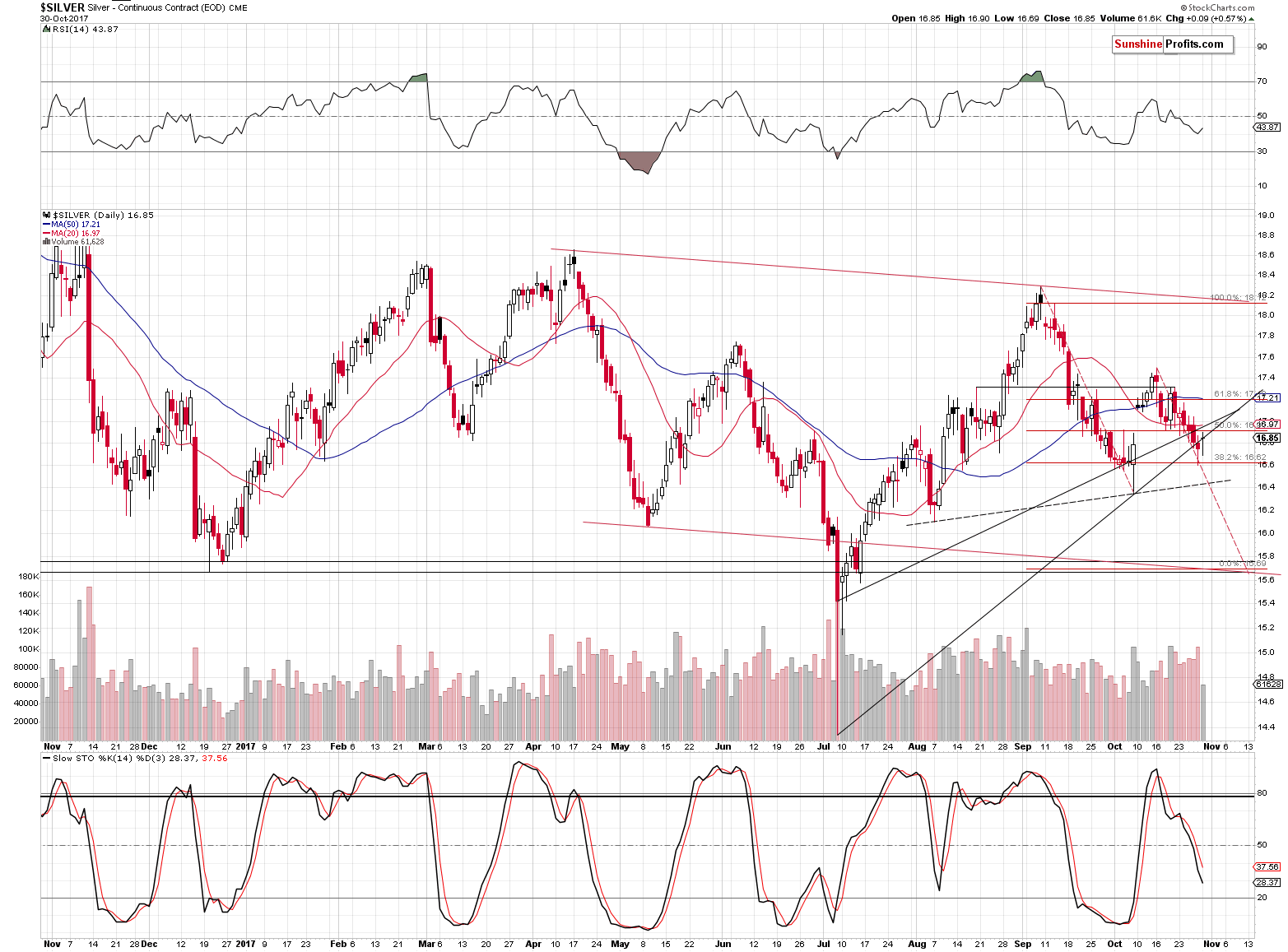
We can say the same thing about silver – here, the difference in the volume seen during the previous days’ declines and yesterday’s small upswing is even more visible.
Moreover, please note that silver is currently confirming a breakdown below the rising support lines based on the July and October lows (in terms of both daily closing prices and intraday lows).
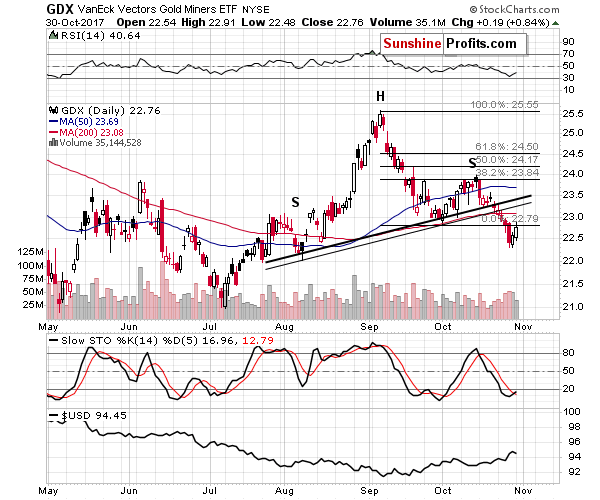
The volume in mining stocks is suggesting the same thing. However, in this case, we also see that yesterday’s upswing might also be seen as a verification of the breakdown below the early October low.
All in all, it doesn’t seem that there’s anything regarding yesterday’s price moves that’s profoundly bullish for the precious metals market.
Before summarizing, we would like to provide you with an update on one of the more long-term-oriented factors that we discussed recently – the link between gold and the Japanese stocks.
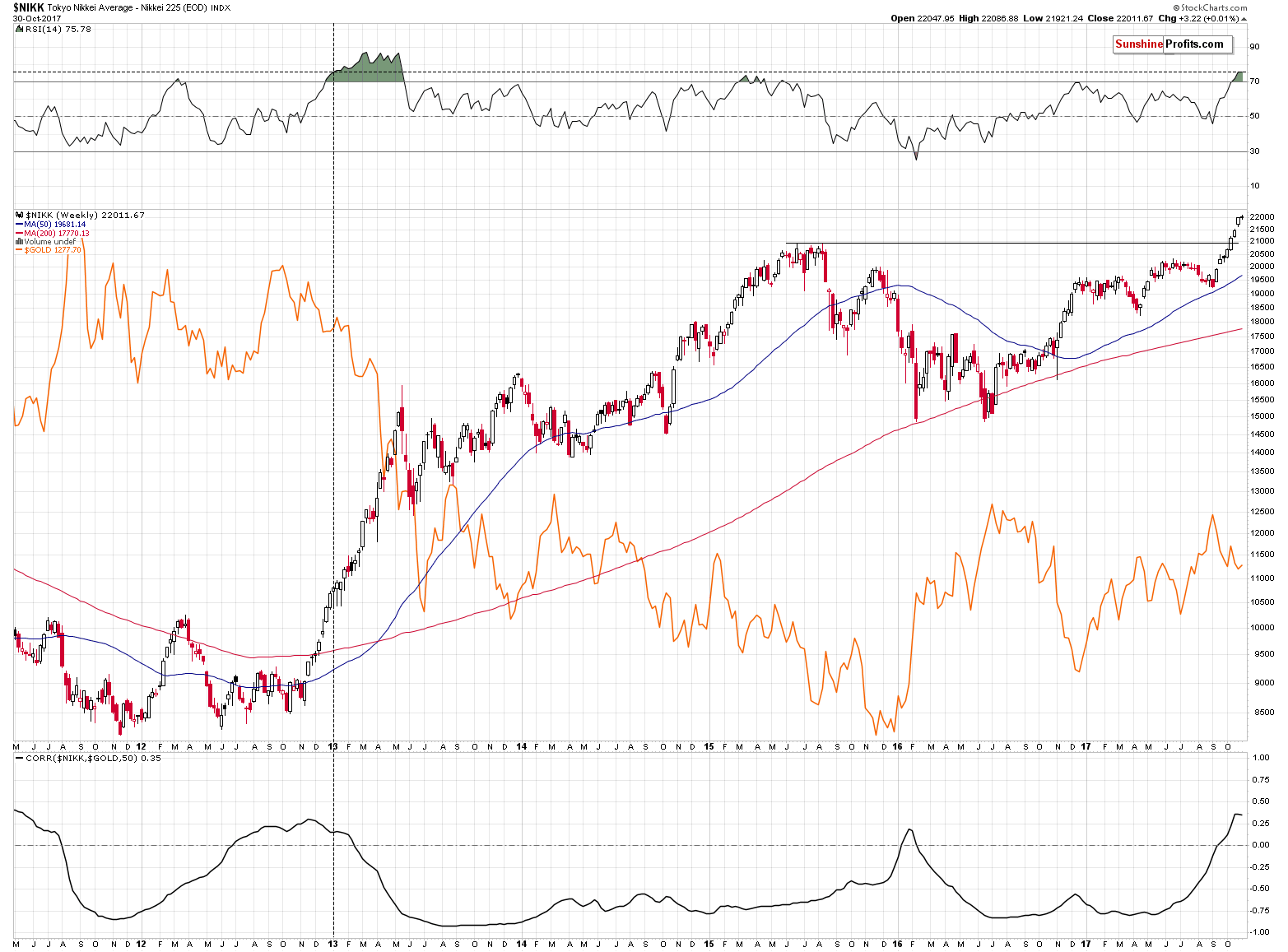
Quoting our previous thoughts on the above chart:
The correlation between Nikkei 225 and gold moved above 0 and the RSI just moved to the 30 level. There was only one similar situation in the recent past and that is when Nikkei was breaking above its previous weekly high. Well, since the Nikkei just broke above its 2015 high in weekly terms, the situations are now very similar.
Back in 2015 it meant that a big rally was about to unfold and the same appears to be likely also this time. Why should we – gold and silver investors – bother with the above analysis? Because Japanese stocks tend to move in the opposite direction to the price of gold in the medium term (in the short-term their moves are not necessarily aligned).
In particular, we should care about the above because the only similar (in fact, very similar) situation in Nikkei was when gold was after the late-2012 top and was during a breather before the huge decline that took place in the following months. This is the same similarity that other long-term factors indicated previously, which means that this scenario is now even more likely to take place in the following weeks and months.
The breakout is more than confirmed and the above remains up-to-date. Today, we would like to add that the RSI indicator might be showing where gold currently is in terms of the decline. The last time when we saw the Nikkei’s RSI moving above 75 was at the beginning of 2013, which is when gold was after a major top (September 2012), after the first correction (October – November 2012) but before a volatile short-term slide to the previous lows.
Right now gold is also after a major top (early September 2017) and the first correction (early October). Is gold before a volatile short-term slide to the previous lows? This seems quite likely based on the above analogy.
Naturally, the above analogy alone is not enough to make such a move very likely – but it’s not the only thing pointing to a 2013-type decline. There are other long-term factors that warn about the same thing – the above simply serves as a confirmation. These factors include: gold’s huge monthly volume, the analogy in the HUI Index, the analogy between the two most recent series of interest rate hikes, and the RSI signal from gold priced in the Japanese yen.
As far as the following weeks are concerned, it seems that we could see another rebound during the decline, but not likely until gold moves to the $1,200 - $1,220 range, which is likely to take place in the first half of November. The analogous range for the USD Index is 95.5 – 96.5 with the 96 level being the most likely target.
We understand that it may not seem believable that gold could decline in the near future or that the decline is going to be really huge, but please keep in mind that this is generally the case with big moves (and the same was the case with the 2013 slide) – they don’t appear believable until they are over and it’s too late to take action at that time. We will continue to monitor the market and strive to keep you informed and prepared for what’s coming.
To summarize:
Trading capital (supplementary part of the portfolio; our opinion): Short positions (150% of the full position) in gold, silver and mining stocks are justified from the risk/reward perspective with the following stop-loss orders and exit price levels / profit-take orders:
- Gold: exit price: $1,218; stop-loss: $1,366; exit price for the DGLD ETN: $51.98; stop-loss for the DGLD ETN $38.74
- Silver: exit price: $15.82; stop-loss: $19.22; exit price for the DSLV ETN: $28.88; stop-loss for the DSLV ETN $17.93
- Mining stocks (price levels for the GDX ETF): exit price: $21.23; stop-loss: $26.34; exit price for the DUST ETF: $29.97; stop-loss for the DUST ETF $21.37
In case one wants to bet on junior mining stocks' prices (we do not suggest doing so – we think senior mining stocks are more predictable in the case of short-term trades – if one wants to do it anyway, we provide the details), here are the stop-loss details and exit prices:
- GDXJ ETF: exit price: $30.28; stop-loss: $45.31
- JDST ETF: exit price: $66.27; stop-loss: $43.12
Long-term capital (core part of the portfolio; our opinion): No positions (in other words: cash)
Insurance capital (core part of the portfolio; our opinion): Full position
Important Details for New Subscribers
Whether you already subscribed or not, we encourage you to find out how to make the most of our alerts and read our replies to the most common alert-and-gold-trading-related-questions.
Please note that the in the trading section we describe the situation for the day that the alert is posted. In other words, it we are writing about a speculative position, it means that it is up-to-date on the day it was posted. We are also featuring the initial target prices, so that you can decide whether keeping a position on a given day is something that is in tune with your approach (some moves are too small for medium-term traders and some might appear too big for day-traders).
Plus, you might want to read why our stop-loss orders are usually relatively far from the current price.
Please note that a full position doesn’t mean using all of the capital for a given trade. You will find details on our thoughts on gold portfolio structuring in the Key Insights section on our website.
As a reminder – “initial target price” means exactly that – an “initial” one, it’s not a price level at which we suggest closing positions. If this becomes the case (like it did in the previous trade) we will refer to these levels as levels of exit orders (exactly as we’ve done previously). Stop-loss levels, however, are naturally not “initial”, but something that, in our opinion, might be entered as an order.
Since it is impossible to synchronize target prices and stop-loss levels for all the ETFs and ETNs with the main markets that we provide these levels for (gold, silver and mining stocks – the GDX ETF), the stop-loss levels and target prices for other ETNs and ETF (among other: UGLD, DGLD, USLV, DSLV, NUGT, DUST, JNUG, JDST) are provided as supplementary, and not as “final”. This means that if a stop-loss or a target level is reached for any of the “additional instruments” (DGLD for instance), but not for the “main instrument” (gold in this case), we will view positions in both gold and DGLD as still open and the stop-loss for DGLD would have to be moved lower. On the other hand, if gold moves to a stop-loss level but DGLD doesn’t, then we will view both positions (in gold and DGLD) as closed. In other words, since it’s not possible to be 100% certain that each related instrument moves to a given level when the underlying instrument does, we can’t provide levels that would be binding. The levels that we do provide are our best estimate of the levels that will correspond to the levels in the underlying assets, but it will be the underlying assets that one will need to focus on regarding the signs pointing to closing a given position or keeping it open. We might adjust the levels in the “additional instruments” without adjusting the levels in the “main instruments”, which will simply mean that we have improved our estimation of these levels, not that we changed our outlook on the markets. We are already working on a tool that would update these levels on a daily basis for the most popular ETFs, ETNs and individual mining stocks.
Our preferred ways to invest in and to trade gold along with the reasoning can be found in the how to buy gold section. Additionally, our preferred ETFs and ETNs can be found in our Gold & Silver ETF Ranking.
As a reminder, Gold & Silver Trading Alerts are posted before or on each trading day (we usually post them before the opening bell, but we don't promise doing that each day). If there's anything urgent, we will send you an additional small alert before posting the main one.
=====
Latest Free Trading Alerts:
Draghi sounded dovish at the recent ECB press conference. Will he sink the price of gold?
Will Dovish Draghi Plunge Gold?
On Friday, the Australian dollar declined against the greenback, which resulted in a decline to important support levels. Will they withstand the selling pressure in the coming week?
AUD/USD - Currency Bears Meet Important Supports
=====
Hand-picked precious-metals-related links:
PRECIOUS-Gold steadies as dollar dips, central banks in focus
Gold Prices Fall In Asia After Official China PMI Dampens Sentiment
BAML Downgrades Gold Outlook; Prices To Average $1,250 In Q1 2018
=====
In other news:
Futures higher with earnings, Fed in focus
Euro Drops as Inflation Slows; Stocks Extend Gains: Markets Wrap
You Wanna See Something Really Scary? Try These Market Charts
Gordon Brown memoirs: Barclays' RBS bid in 2008 is a staggering revelation
Surge in UK consumer borrowing fuels likely interest rate rise
Catalan separatists are seeking refuge in Belgium — causing an awkward rift between EU nations
=====
Thank you.
Sincerely,
Przemyslaw Radomski, CFA
Founder, Editor-in-chief, Gold & Silver Fund Manager
Gold & Silver Trading Alerts
Forex Trading Alerts
Oil Investment Updates
Oil Trading Alerts



